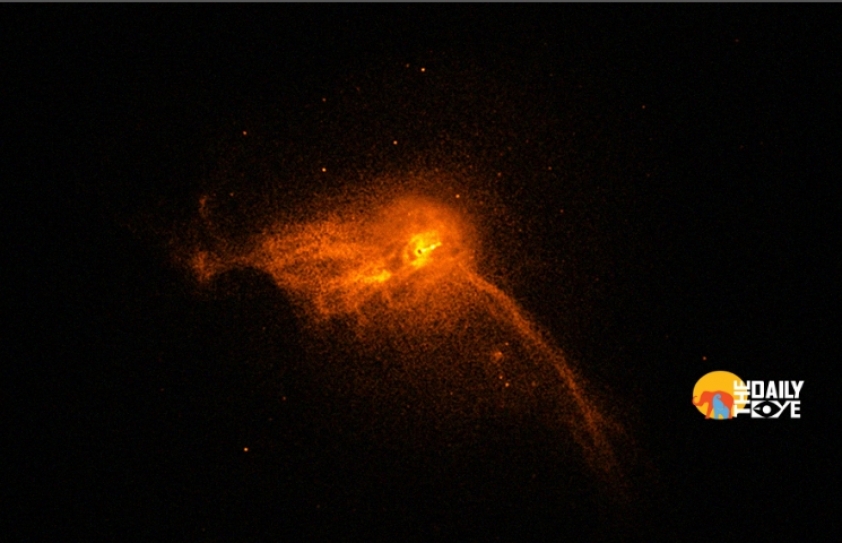
Astronomers release the first ever picture of a black hole
by Shruthi Venkatesh April 15 2019, 3:33 pm Estimated Reading Time: 3 mins, 59 secsAstronomers have captured the first ever image of a Black Hole located in the distant galaxy. The image was captured on the 10th of April, which was described by the scientists as “a monster”. The black hole is 500 million trillion km away and was captured by the Event Horizon Telescope (EHT), a network of eight linked telescopes across the world.
A black hole is nothing but a huge amount of matter packed densely in a small area giving it an immense gravitational pull. It measures three million times the size of the Earth. The gravity is so strong that nothing, not even light can escape them. They are believed to be formed by collapsed stars. The presence of black holes affects the surrounding environment in extreme ways. Prof Heino Falcke, of Radboud University in the Netherlands, who proposed the experiment, told BBC News that the black hole was found in a galaxy called Messier 87, or M87.
“What we see is larger than the size of our entire Solar System,” he said. “It has a mass 6.5 billion times that of the Sun. And it is one of the heaviest black holes that we think exists. It is an absolute monster, the heavyweight champion of black holes in the Universe.” He describes the image as a “ring of fire”, surrounding a perfectly circular dark hole. The edge of the dark circle at the center is the point at which the gas enters the black hole, which is an object where there is a large gravitational pull.
1.jpg)
The Event Horizon Telescope Array and Katie Bouman who developed the algorithm
According to Dr. Ziri Younsi, of University College London - who is part of the EHT collaboration, said that the image matches what theoretical physicists and indeed, Hollywood directors, imagined black holes would look like. “Although they are relatively simple objects, black holes raise some of the most complex questions about the nature of space and time, and ultimately of our existence,” he said. “It is remarkable that the image we observe is so similar to that which we obtain from our theoretical calculations. So far, it looks like Einstein is correct once again”.
This first image will enable researchers to learn more about such mysterious objects. Till now, no one knows how the bright ring around the hole was formed and also raises a question of what happens when an object falls into the black hole. This is termed to the event horizon. It is described to be the “point of no return”, beyond which it is impossible to escape the gravitational effects of the black hole.
The BBC reports that Prof Falcke had the idea for the project when he was a PhD student in 1993. He paved a way for something possible while it was assumed to be impossible. But he was the first to realize that a certain type of radio emission would be generated close to and all around the black hole, which would be powerful enough to be detected by telescopes on Earth. He also recalled reading a scientific paper from 1973 that suggested that because of their enormous gravity, black holes appear 2.5 times larger than they actually are.
After arguing his case for 20 years, Prof Falcke persuaded the European Research Council to fund the project. The National Science Foundation and agencies in East Asia then joined in to bankroll the project to the tune of more than £40m. This investment made it till the publication of the image. Prof Falcke told that he felt that “its mission accomplished”.
He said: “It has been a long journey, but this is what I wanted to see with my own eyes. I wanted to know is this real?”
A single telescope isn’t enough to capture the image of the Black hole. So, Prof Sheperd Doeleman of the Harvard-Smithsonian Centre for Astrophysics led the project to set up a network of eight linked telescopes. Together, they formed the Event Horizon Telescope.
A team of 200 scientists worked towards the experiment of M87 and scanned its heart over a period of 10 days. The information they gathered was soon sent across the internet. Katie Bouman a PhD student at MIT developed an algorithm that pieced together the data from the EHT. Without her contribution the project would not have been possible – reports BBC. Prof Doeleman described the achievement as “an extraordinary scientific feat”.
“We have achieved something presumed to be impossible just a generation ago,” he said. “Breakthroughs in technology, connections between the world’s best radio observatories, and innovative algorithms all came together to open an entirely new window on black holes.”




-173X130.jpg)
-173X130.jpg)
-173X130.jpg)
-173X130.jpg)
_(1)-173X130.jpg)

-173X130.jpg)
